Matisse & Picasso-
1- I chose this video for a couple different reasons. In previous art classes I have taken we have talked about Picasso and I also seen some of his paintings at the art gallery. I never heard of Matisse and I know who Picasso is so I figured this video would be beneficial to watch.
2- A family called the Steins were the first to buy Matisse's painting which was of his wife. They thought that Matisse and Picasso were similar and should meet. They said they both have the strength of a genius. Matisse was unaware of his talent for the first 20 years of his life. His paintings were soft and gentle. Picasso's paintings they showed looked scary and evil. These paintings resemble "Life's a bitch". Matisse's portrait of his daughter, Picasso loved and kept it for as long as he lived. In 1912 Picasso invented the first collage which was made by cloth. Matisse's lifeline is the Arabesque. Dance was a symbol in his paintings that looked like sculptures.
3- This video relates to the text by stating facts and information about Picasso. They each show their art work and the works that made it big.
4- I liked this video. It was pretty long and hard to stay focused. This video added more depth to my knowledge of these artists by showing more images from them.
Expressionism-
1- I chose this video because expressionism expresses color throughout paintings. I thought it would be interesting to learn how artists represent stories and events through color in their paintings.
2- Expressionism emphasizes color's emotional properties while demonstrating far less concern than the Fauves had with the formal and structural composition of color. The pictures shown use color to demonstrate what is going on and what it is expressing to the audience. Color plays a important role in expressionism.
3-These relates to the text by showing more examples of expressionism. The text states important ideas and facts about expressionism. Where as the video shows many images of color being used to imply a story line.
4- This video was interesting and I am glad I chose it. It adds depth to my understanding of expressionism by all the examples shown from the video.
Wednesday, October 30, 2013
Monday, October 28, 2013
Module 10- Mask
1- Inspiration Images-
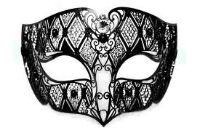

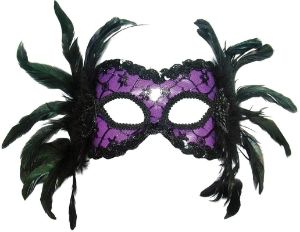
2- The masks I chose were an inspiration to my ideas and thoughts for creating my own mask. I like the masquerade masks, they add fun and style. They use color and pattern to represent a certain holiday, tradition or simply used for a costume. I liked how they had the same type of pattern around or along the mask.
3- Sketch-
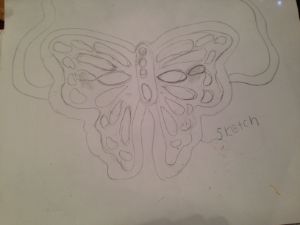
Final Mask-
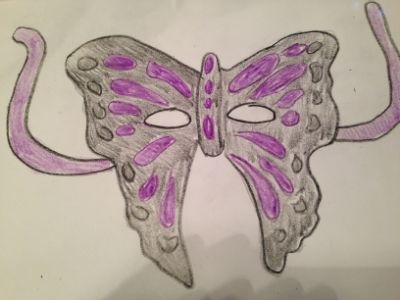
4- In my finished mask I used color to represent the mood. The purple, black and grey represent mysterious and could be worn for a masquerade. I also used pattern in my mask. The pattern repeats itself and mirrors itself on each side. Balance occurs in my mask as well. Each side is the same in shape and size.
5- I thought it was fun creating my mask. I looked at a bunch of different images online to figure out a perfect mask to create. I liked the colors I used and the butterfly as the mask. I liked this project it gave you an opportunity to explore different kinds of masks and their elements and principles.



2- The masks I chose were an inspiration to my ideas and thoughts for creating my own mask. I like the masquerade masks, they add fun and style. They use color and pattern to represent a certain holiday, tradition or simply used for a costume. I liked how they had the same type of pattern around or along the mask.
3- Sketch-

Final Mask-

4- In my finished mask I used color to represent the mood. The purple, black and grey represent mysterious and could be worn for a masquerade. I also used pattern in my mask. The pattern repeats itself and mirrors itself on each side. Balance occurs in my mask as well. Each side is the same in shape and size.
5- I thought it was fun creating my mask. I looked at a bunch of different images online to figure out a perfect mask to create. I liked the colors I used and the butterfly as the mask. I liked this project it gave you an opportunity to explore different kinds of masks and their elements and principles.
Saturday, October 26, 2013
Module 10 video
Buddhism
1- I chose this video because I thought it would be interesting to learn in depth facts and details about the religion Buddhism.
2- The religion Buddhism began in India by the name of Siddhartha Gautama. His father was the king and he had everything he could ever want in life. Gautama one day saw the world differently after seeing people living sickness and on the streets. He wanted to send the message of love, gentleness and serenity. Gautama wanted to share his enlightment with people for support. The teaching of Buddhism spread through India. After Gautama died Buddhism spread 2 different ways, the monks and Vinaya. During the 3rd and 7th century Sanche became the center of the Buddhist art and architecture. The great stoop is where people and pilgrims go to admire the Buddha gallery and life. Pilgrims from all parts of India made their way to the great stoop and the great gateway.
3- This video added more depth to my learning of Buddhism religion by showing more detailed photos and places that explains and symbolizes Buddhism.
4- I really liked this video. I am happy I chose it because it was interesting to watch and it wasn't boring like some other videos we have watched.
Hinduism-
1- I picked this video because I am interested in learning about the different cultures and religions from millions of years go.
2- I learned that the Great river Ganges was a powerful symbol to the Hinduism people. It was symbolic for god's love of earth and people. To the Hinduism people they believed in death and re-carnation. They used to burn people when dead because they believed their spirit and soul would come back to life. The Christian Hindu's believed in millions of years through rebirth and death. In the video they had a ceremony representing mother nature of the great river Ganges. Oil lamps were offered and were important in art and architecture. Hindu's invested in tiny shrines and their decorations.
3- The text and video do provide similar information about Hinduism. The video shows ceremonies, what they do to dead bodies and how the great river Ganges affects their way of living.
4- I liked this video because it taught me many things about the Hindu's. I thought it was interesting their perspective on birth and re-carnation along with rebirth and death.
1- I chose this video because I thought it would be interesting to learn in depth facts and details about the religion Buddhism.
2- The religion Buddhism began in India by the name of Siddhartha Gautama. His father was the king and he had everything he could ever want in life. Gautama one day saw the world differently after seeing people living sickness and on the streets. He wanted to send the message of love, gentleness and serenity. Gautama wanted to share his enlightment with people for support. The teaching of Buddhism spread through India. After Gautama died Buddhism spread 2 different ways, the monks and Vinaya. During the 3rd and 7th century Sanche became the center of the Buddhist art and architecture. The great stoop is where people and pilgrims go to admire the Buddha gallery and life. Pilgrims from all parts of India made their way to the great stoop and the great gateway.
3- This video added more depth to my learning of Buddhism religion by showing more detailed photos and places that explains and symbolizes Buddhism.
4- I really liked this video. I am happy I chose it because it was interesting to watch and it wasn't boring like some other videos we have watched.
Hinduism-
1- I picked this video because I am interested in learning about the different cultures and religions from millions of years go.
2- I learned that the Great river Ganges was a powerful symbol to the Hinduism people. It was symbolic for god's love of earth and people. To the Hinduism people they believed in death and re-carnation. They used to burn people when dead because they believed their spirit and soul would come back to life. The Christian Hindu's believed in millions of years through rebirth and death. In the video they had a ceremony representing mother nature of the great river Ganges. Oil lamps were offered and were important in art and architecture. Hindu's invested in tiny shrines and their decorations.
3- The text and video do provide similar information about Hinduism. The video shows ceremonies, what they do to dead bodies and how the great river Ganges affects their way of living.
4- I liked this video because it taught me many things about the Hindu's. I thought it was interesting their perspective on birth and re-carnation along with rebirth and death.
Monday, October 21, 2013
module 9 project
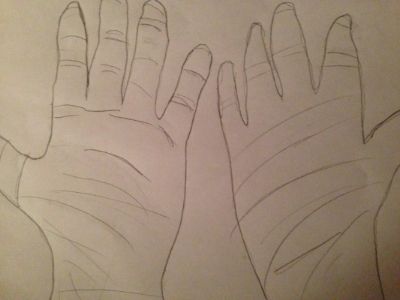
1-I thought using your hand for this project was easier than the other projects. I would rather draw or trace an object than drawing something made off the top of your head.
2- I used a pencil when drawing this project. I think it's easier to draw with a pencil rather then anything else. I feel more comfortable using a pencil when drawing so I can erase if I need to or make a mistake.
3- I actually did not like using my non dominant hand. I found it a lot harder because I never try to use that hand to draw or write, so it felt uncomfortable. I found myself getting aggravated because it was very difficult.
4- I think my drawings are decent. I do not usually draw so I see this as a pretty good drawing. It took me a couple try's to get it the way I wanted it too. I do think using my dominant hand was a better drawing.
5- I would never consider using my non- dominant hand for a drawing in the future. It felt extremely uncomfortable.
Module 9
Albrecht Durer- Image of A Master
1- I chose this video honestly because it was the first one I clicked on and only twenty minutes. It seems interesting. I like videos that focus on one artists life and career.
2- Gothic art opened new ideas in ancient times. Durer was a very skilled artist and started when he was very young. At thirteen years old he drew his first portrait. When he was 19 he drew a portrait of his master as well. Recently discovered a portrait of Durer's mother. She had 18 children and buried 15 of them. In 1544 in drew a sketch of his mother, which looked to be as she was aging. I knew this because she had creases in her face. Durer made wood cuts which is a german manner. When grown Durer traveled as a craftsmen. He was married when he was 22 to a bride that was 15 years old, from a wealthy family. Two months after the wedding he began his travels again for about 4 to 5 months. His wife gave him no children.
3- This relates to the text by similar topics. For example there are artists in the text that can relate to this artist.
4- The video shows more in depth facts, portraits and paintings. I liked this video. It was interesting to learn about Durer's life. He survived traveling on his own making crafts. People do not do that now a days and wouldn't be able to survive.
Velazquez-
1- I chose this video because it looked different and sounded unique from the rest.
2- Velazquez was a Spanish painter born in 1599 in Seville. Velazquez drew paintings for the King, whatever his request may be Velazquez would deliver willingly. He would draw portraits of the king and his family. When he was 24 years old he was named the court painter to Phillip the 4th. Velazquez saw the king as elegant, ageless and sad. He went to Italy for two years to look, copy and study Italian paintings. Velazquez died in 1660.
3- This video relates to the text by covering similarities between painters around the world and their careers.
4- I thought this video was very interesting. I thought it was cool that Velazquez created portraits for royal people.
1- I chose this video honestly because it was the first one I clicked on and only twenty minutes. It seems interesting. I like videos that focus on one artists life and career.
2- Gothic art opened new ideas in ancient times. Durer was a very skilled artist and started when he was very young. At thirteen years old he drew his first portrait. When he was 19 he drew a portrait of his master as well. Recently discovered a portrait of Durer's mother. She had 18 children and buried 15 of them. In 1544 in drew a sketch of his mother, which looked to be as she was aging. I knew this because she had creases in her face. Durer made wood cuts which is a german manner. When grown Durer traveled as a craftsmen. He was married when he was 22 to a bride that was 15 years old, from a wealthy family. Two months after the wedding he began his travels again for about 4 to 5 months. His wife gave him no children.
3- This relates to the text by similar topics. For example there are artists in the text that can relate to this artist.
4- The video shows more in depth facts, portraits and paintings. I liked this video. It was interesting to learn about Durer's life. He survived traveling on his own making crafts. People do not do that now a days and wouldn't be able to survive.
Velazquez-
1- I chose this video because it looked different and sounded unique from the rest.
2- Velazquez was a Spanish painter born in 1599 in Seville. Velazquez drew paintings for the King, whatever his request may be Velazquez would deliver willingly. He would draw portraits of the king and his family. When he was 24 years old he was named the court painter to Phillip the 4th. Velazquez saw the king as elegant, ageless and sad. He went to Italy for two years to look, copy and study Italian paintings. Velazquez died in 1660.
3- This video relates to the text by covering similarities between painters around the world and their careers.
4- I thought this video was very interesting. I thought it was cool that Velazquez created portraits for royal people.
Sunday, October 13, 2013
Module 8
Human Video-
1- This video was required to watch, and I'm glad it was. I most likely would of picked this one if it wasn't already required.
2- In the video More human than human I learned facts about the nomadic people. They hunted and gathered in small groups. These people never stayed in one spot and were always moving. I cant imagine living like that! In most paintings and sculptures woman were portrayed with big legs, stomach and breasts, but regular face and arms. People were unsure of why artists portrayed women this way, they guessed it was a symbol of motherhood. Early humans were stimulated by these images and fat was highly desirable. The famous figure was is called Venus. Brain scientists figured out why ancient humans portrayed women this way. Scientists compared seagals to the Venus to complete their findings. They found out that baby seagals are attached to their mothers by the red strip on their beak. Ancient humans were pre-programmed to exaggerate what mattered most.
3- The video and text relate to each other by the same topics discussed. Also there were similar images shown. They both related to the same historical time periods.
4- I enjoyed the video and am glad it was required. I learned a lot and thought it was very interesting. The images shown gave more depth to my understanding of the material. This video showed symbols and places as to where the narrator was discussing.
Art and Life in the Middle Ages-
1- I chose this video because I thought it would be educational to learn in depth facts and history from the middle ages.
2- In the video the author of the prayer book shown and talked about was Luttrell Psalter. In the prayer book they showed monsters, daily life and animals on every page. Whether it be on the top, bottom, middle and in between the lines on the page. Luttrell has images of people on the pages, people seem to think their people he once knew. The images show facial expressions, hair styles and fashion. On one of the pages in the top corner there is a gray face. People seem to think it is Luttrell but no one is sure. In 1315- 1316 these time periods resulted in many people dying. Also in this time farming was the way of producing food. Woman would make cloth and spin. Spinning took a lot of time, they compare this to woman cooking.
3- This video relates to the text by discussing similar facts during the middle ages.
4- I liked this video and happy I chose it as my choose. This video showed different images of people that may have lived in ancient times. Also it showed us a prayer book and taught us about the master Luttrell Psalter.
1- This video was required to watch, and I'm glad it was. I most likely would of picked this one if it wasn't already required.
2- In the video More human than human I learned facts about the nomadic people. They hunted and gathered in small groups. These people never stayed in one spot and were always moving. I cant imagine living like that! In most paintings and sculptures woman were portrayed with big legs, stomach and breasts, but regular face and arms. People were unsure of why artists portrayed women this way, they guessed it was a symbol of motherhood. Early humans were stimulated by these images and fat was highly desirable. The famous figure was is called Venus. Brain scientists figured out why ancient humans portrayed women this way. Scientists compared seagals to the Venus to complete their findings. They found out that baby seagals are attached to their mothers by the red strip on their beak. Ancient humans were pre-programmed to exaggerate what mattered most.
3- The video and text relate to each other by the same topics discussed. Also there were similar images shown. They both related to the same historical time periods.
4- I enjoyed the video and am glad it was required. I learned a lot and thought it was very interesting. The images shown gave more depth to my understanding of the material. This video showed symbols and places as to where the narrator was discussing.
Art and Life in the Middle Ages-
1- I chose this video because I thought it would be educational to learn in depth facts and history from the middle ages.
2- In the video the author of the prayer book shown and talked about was Luttrell Psalter. In the prayer book they showed monsters, daily life and animals on every page. Whether it be on the top, bottom, middle and in between the lines on the page. Luttrell has images of people on the pages, people seem to think their people he once knew. The images show facial expressions, hair styles and fashion. On one of the pages in the top corner there is a gray face. People seem to think it is Luttrell but no one is sure. In 1315- 1316 these time periods resulted in many people dying. Also in this time farming was the way of producing food. Woman would make cloth and spin. Spinning took a lot of time, they compare this to woman cooking.
3- This video relates to the text by discussing similar facts during the middle ages.
4- I liked this video and happy I chose it as my choose. This video showed different images of people that may have lived in ancient times. Also it showed us a prayer book and taught us about the master Luttrell Psalter.
Thursday, October 3, 2013
Video Blogs Module 7
Architecture- Science of Design-
1. Key concepts learned- There were many concepts that I learned throughout this video. Most of which I had no clue even were decisions and choices while creating a building. I learned that wind blowing on top of a 100 story building is 4 times more violent then on a 50 feet building. The buildings need to have 5-7 seconds to cover farthest and current position, this can cause motion sickness, stop of elevators and damage of the structure. Experts determine how buildings and their surroundings will react under thrust winds. They compare data to meterological statistics from the past 10 to 20 years to predict weather conditions.
2- This video relates to the text by showing us the same type of high rises and buildings. They also both talk about the structures and creations of buildings.
3- I really liked this film I thought it brought more detailed and descriptive images and was a eye opener for how experts create buildings. I never knew there was a whole side of research before building something. This showed me more of a depth of understanding architecture by showing experts steps of how they do things.
4. I choose this film because it seemed interesting while looking through them. I am glad I chose this one because I actually was interesting in it and wanted to learn more.
Frank Gehry- Architecture as Art
1. During the 20th century there is always moving chaos which falls onto sense of movement. Gehry says he felt that what you put in a building connects with the people in the building as well. It gives people feelings and is humanistic. Gehry designed malls, apartments and buildings all around the world. He also developed his own architecture vocabulary that would eventually determine large and sculptural form.
2.In the text we read about other architectures and their experiences, creativity and works. In the video I got the opportunity to learn about another architect.
3. This video was a little bit more duller then the first one I chose. I liked the parts where they showed Gehry and him working on pieces of art.
4. I chose this film because I thought it would be interesting to see and learn about an architects works and past. I like videos that goes inside someone famous or well knowns life.
1. Key concepts learned- There were many concepts that I learned throughout this video. Most of which I had no clue even were decisions and choices while creating a building. I learned that wind blowing on top of a 100 story building is 4 times more violent then on a 50 feet building. The buildings need to have 5-7 seconds to cover farthest and current position, this can cause motion sickness, stop of elevators and damage of the structure. Experts determine how buildings and their surroundings will react under thrust winds. They compare data to meterological statistics from the past 10 to 20 years to predict weather conditions.
2- This video relates to the text by showing us the same type of high rises and buildings. They also both talk about the structures and creations of buildings.
3- I really liked this film I thought it brought more detailed and descriptive images and was a eye opener for how experts create buildings. I never knew there was a whole side of research before building something. This showed me more of a depth of understanding architecture by showing experts steps of how they do things.
4. I choose this film because it seemed interesting while looking through them. I am glad I chose this one because I actually was interesting in it and wanted to learn more.
Frank Gehry- Architecture as Art
1. During the 20th century there is always moving chaos which falls onto sense of movement. Gehry says he felt that what you put in a building connects with the people in the building as well. It gives people feelings and is humanistic. Gehry designed malls, apartments and buildings all around the world. He also developed his own architecture vocabulary that would eventually determine large and sculptural form.
2.In the text we read about other architectures and their experiences, creativity and works. In the video I got the opportunity to learn about another architect.
3. This video was a little bit more duller then the first one I chose. I liked the parts where they showed Gehry and him working on pieces of art.
4. I chose this film because I thought it would be interesting to see and learn about an architects works and past. I like videos that goes inside someone famous or well knowns life.
Peer Blogs
http://kalifoley.blogspot.com/2013/09/art-gallery-visit.html#comment-form
http://jess1cacunn1ngham.blogspot.com/2013/09/my-logo.html?showComment=1380663156904#c974340093382066680
2- While making my photobucket slideshow I saw different elements in a bunch of the pictures I used. Kali's photobucket slideshow she used pictures of her backyard which was a really good idea. I think you can find more of the element in objects outside. Such as contrast and color. For all the pictures she chose for each element I thought went together and made sense. She used pictures that I would of used to describe each element as well. Jessica's photobucket I also thought her pictures matched with each element. She was nervous she was not going to be able to find the right pictures and I thought that as well.
3- Jessica's choice of pieces were different then mine. The ones she picked out were interesting and I see that more now looking at the pictures of them. The convergence by Jason Pollock looks really interesting and I didn't notice it as much as the other ones at the gallery. Kali's pictures she chose were very similar to mine. We both like the Polarity. We all thought the Wood Iron Rods looked like they were moving even though they weren't. I also really liked the stairs when you first walked in, I has to really watch walking down them because they were so filled with colors and stripes, it was very different.
4- Jessica chose the Triumph of the French Painting, which looks really interesting. It looks to me that there is a story behind it that people would like to know more about. It has a variety of colors to make the piece more alive. It also looks like there is emotion behind it as well. Kali chose the "Fog” by Susie Rosmarin. I thought this piece was really cool. I remember seeing it at the gallery and couldn't stop starring at it. So many of the pieces there really make you stop and stare for a while.
5. I think it is interesting to see what other classmates are interested in. Being an online class no one knows each other, so this gives us a opportunity to see what their like. I find it valuable to see how and what other people do for the projects. This is my first art class and a elective so I am basing off the directions not any examples. This assignment shows us what other peoples ideas are and we can learn from them.
6- Even though I did not have any classmates respond to my artwork, I feel this assignment helped me for my future assignments and projects.
http://jess1cacunn1ngham.blogspot.com/2013/09/my-logo.html?showComment=1380663156904#c974340093382066680
2- While making my photobucket slideshow I saw different elements in a bunch of the pictures I used. Kali's photobucket slideshow she used pictures of her backyard which was a really good idea. I think you can find more of the element in objects outside. Such as contrast and color. For all the pictures she chose for each element I thought went together and made sense. She used pictures that I would of used to describe each element as well. Jessica's photobucket I also thought her pictures matched with each element. She was nervous she was not going to be able to find the right pictures and I thought that as well.
3- Jessica's choice of pieces were different then mine. The ones she picked out were interesting and I see that more now looking at the pictures of them. The convergence by Jason Pollock looks really interesting and I didn't notice it as much as the other ones at the gallery. Kali's pictures she chose were very similar to mine. We both like the Polarity. We all thought the Wood Iron Rods looked like they were moving even though they weren't. I also really liked the stairs when you first walked in, I has to really watch walking down them because they were so filled with colors and stripes, it was very different.
4- Jessica chose the Triumph of the French Painting, which looks really interesting. It looks to me that there is a story behind it that people would like to know more about. It has a variety of colors to make the piece more alive. It also looks like there is emotion behind it as well. Kali chose the "Fog” by Susie Rosmarin. I thought this piece was really cool. I remember seeing it at the gallery and couldn't stop starring at it. So many of the pieces there really make you stop and stare for a while.
5. I think it is interesting to see what other classmates are interested in. Being an online class no one knows each other, so this gives us a opportunity to see what their like. I find it valuable to see how and what other people do for the projects. This is my first art class and a elective so I am basing off the directions not any examples. This assignment shows us what other peoples ideas are and we can learn from them.
6- Even though I did not have any classmates respond to my artwork, I feel this assignment helped me for my future assignments and projects.
Subscribe to:
Comments (Atom)